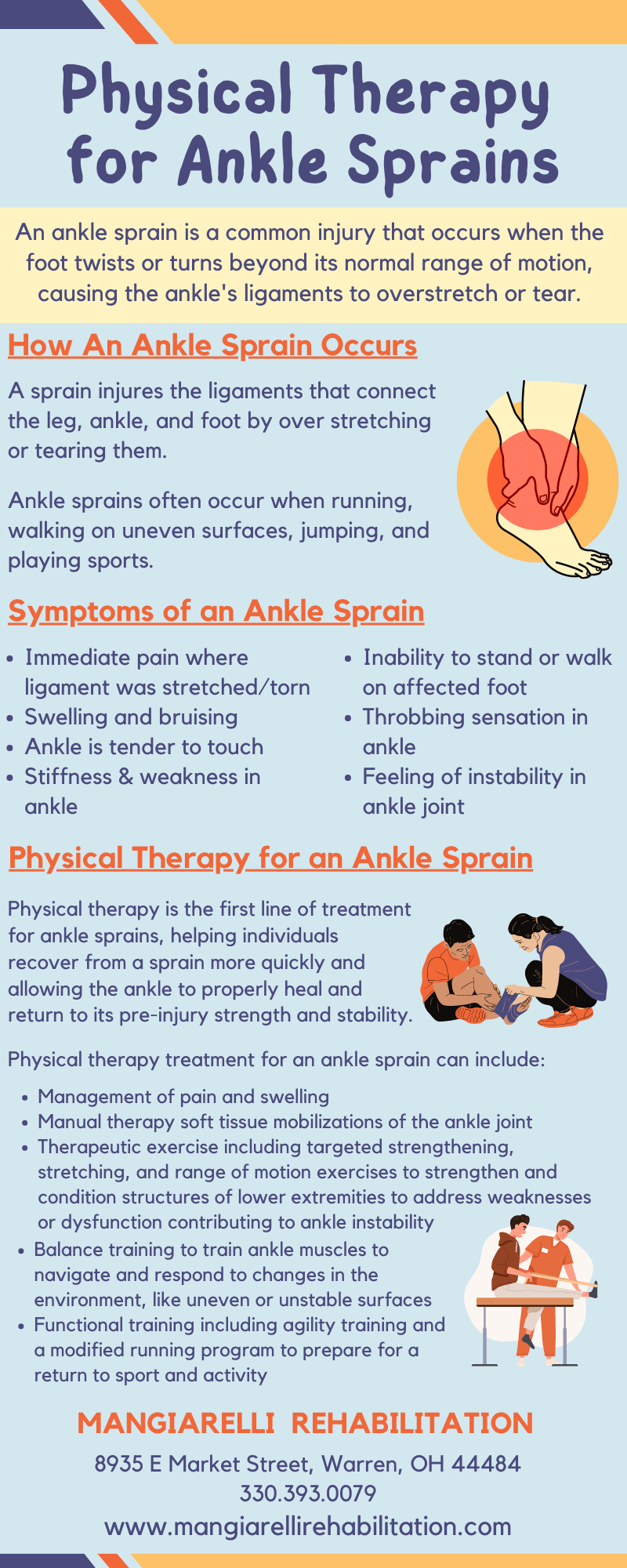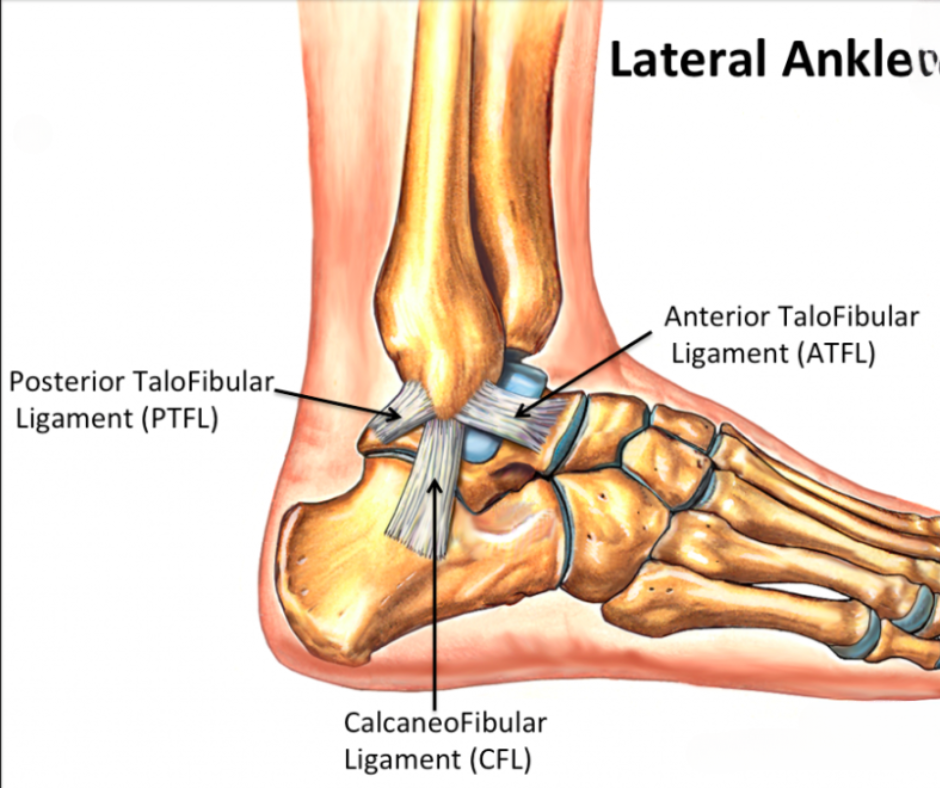Physical Therapy for Ankle Sprains [Infographic]
An ankle sprain is a common injury that occurs when the foot twists or turns beyond its normal range of movement, causing the ankle’s ligaments to overstretch or tear. Ankle sprains account for up to 40% of lower extremity sports injuries and 15% of all sports injuries of any kind in the United States. Lateral ankle sprains (LAS) are the most common ankle sprains, particularly among rugby, tennis, football, volleyball, and basketball players whose sports require quick cutting and pivoting movements. Physical therapy is the first line of treatment for ankle sprains, effectively restoring mobility, strength, and function in the injured ankle, preventing re-injury, and ensuring a safe return to sport through a targeted exercise and manual therapy rehabilitation program.
Anatomy of the Ankle
The ankle joint joins the foot to the lower leg and is where the shin bone, calf bone, and talus bone meet. The ankle is made up of cartilage, ligaments, muscles, nerves, and blood vessels. The ankle joint can bend and flex into plantar flexion (down, away from the body) or in dorsiflexion (up, toward the body).
The ligaments of the ankle are the structures damaged during an ankle sprain. Ligaments connect the bones in your foot to your lower leg bones. There are three types of ligaments in the ankle: medial, lateral, and syndesmotic. Syndesmotic ligaments are the four ligaments that connect the tibia and fibula. The medial (deltoid) ligaments start at the bottom end of the tibia and fan out to connect with the talus, heel bone, and other bones of the foot. The lateral ligaments start at the end of the fibula, which forms the bump on the outside of the ankle and connect to the talus and heel bone. The lateral ligaments are the most commonly overstretched or torn ligaments in an ankle sprain.
How An Ankle Sprain Occurs
An ankle sprain is a common injury that occurs when the foot twists or turns beyond its normal range of movement, causing the ankle’s ligaments to overstretch or tear. Ankle sprains often occur when running, walking on uneven surfaces, jumping, or playing sports that require quick changes in direction, pivoting, and cutting.
Ankle sprains account for up to 40% of lower extremity sports injuries and 15% of all sports injuries of any kind in the United States. Lateral ankle sprains (LAS) are the most common ankle sprains, particularly among rugby, tennis, football, volleyball, and basketball players. Many who experience a LAS suffer from recurrent ankle sprains and persistent mechanical and neuromuscular impairments of the ankle. Up to 40% of those who experience an ankle sprain can develop chronic symptoms lasting up to a year and 20% experience chronic ankle instability during activity. This occurs due to insufficient rehabilitation and thereby not regaining proper ankle muscle strength or balance before returning to activity. The largest ankle sprain re-injury rates occur in junior basketball (47%), volleyball (46%), and American football (43%).
There are three grades that describe the severity of the ankle sprain:
Grade 1: a mild injury in which the ligaments are overstretched. Recovery can take two months with full strength returning within a few months.
Grade 2: a moderate injury where ligaments are overstretched and partially torn. Recovery can take 6 to 12 weeks.
Grade 3: a severe injury in which the ligaments are completely torn. Recovery can take 9 months to a year to fully heal.
Risk factors for an ankle sprain include a previous ankle sprain, excess body weight, female anatomy, muscle weakness of the leg, hip, and ankle complexes, balance problems, and chronic foot or ankle problems. Playing high intensity sports requiring significant agility and cutting movements can also heighten the risk of an ankle sprain, e.g., soccer, football, rugby, and basketball.
Symptoms of an ankle sprain include:
Immediate pain, swelling, and bruising where the ligament was stretched or torn
Tenderness to touch at site of injury
Inability to stand or walk on the affected foot
Throbbing sensation in the ankle
Stiffness and weakness in the ankle
Feeling of instability in your ankle joint
Physical Therapy for an Ankle Sprain
Physical therapy treatment for an ankle sprain can include:
Pain and swelling management using ice, heat, ultrasound, and electrical stimulation to reduce pain and limit swelling, particularly during the first 24-48 hours post-injury.
Manual therapy using soft tissue mobilizations to improve the mobility of the foot and ankle and gently restore range of motion in the ankle.
Therapeutic exercise involving strengthening and conditioning of all the structures of the lower extremities, from the hip through the quadriceps and hamstrings, knee, lower leg, ankle, and foot muscles. The therapist works to address muscle weaknesses or dysfunction throughout the lower extremity that may be contributing to ankle instability.
Range of motion exercises starting with passive movements that the physical therapist guides you through before progressing to active exercises to progressively restore normal range of movement in the ankle complex.
Targeted stretching to increase flexibility in tight foot and ankle muscles.
Strengthening exercises using cuff weights, stretch bands, and weight-lifting equipment to rebuild strength in weakened ankle muscles and ensure strength throughout the lower extremity to minimize stress on the ankle.
Balance training is essential to retrain the ankle to respond quickly to changes in the environment and be able to safely navigate uneven and unstable surfaces. The therapist may begin with the individual doing exercises on a single leg or balance board in the parallel bars for support before moving on to dynamic balance training exercises on the Astroturf using a balance training ladder or small hurdles.
Functional sport-specific training, including agility training to prepare for cutting and pivoting on the Astroturf, and a progressive return to running program.
Numerous research studies confirm that physical therapy exercise and manual therapy treatment is highly effective in treating ankle sprains, reducing pain, improving function and mobility, and ensuring a safe return to sport with low re-injury risk. Several studies focused on the effectiveness of manual therapy and exercise in the treatment of LAS. In a 2016 study, researchers found that the addition of manual therapy to proprioceptive and strengthening exercises elicited lower pain levels and reduced self-reported ankle instability. Another study noted that the addition of manual therapy to therapeutic exercise after a LAS improved short-and long-term function and decreased short-and long-term pain.
A recent 2022 meta-analysis found exercise-based rehabilitation programs significantly reduced re-injury prevalence among those with acute ankle sprains after 12 months. Another study assessing 2,376 patients with an acute ankle sprain confirms this, with researchers noting that exercise therapy helps to prevent recurrent sprains and that manual mobilizations appeared to positively effect restoring ankle range of motion.
One study assessed 74 patients, half of whom received a home exercise program to treat an ankle sprain and half of whom received a combined manual therapy and supervised exercise program treatment. Those who received manual therapy and exercise experienced a 70% reduction in pain at 4 weeks and more than a 92% reduction in pain at 6 months. Those who received the home exercise program only had a 39% reduction in pain at 4 weeks and 80% reduction at 6 months. Those in the manual therapy and exercise group also had their ability to perform daily activities improve from 66% at the initial exam to 87% at 4 weeks and 97% at 6 months. In contrast, the home exercise group only saw improved function to 73% at 4 weeks and 88% at 6 months.
Have you experienced an ankle sprain or do you deal with chronic ankle instability post-sprain? Work with our physical therapists to reduce ankle pain and restore function and strength in your ankle for a safe return to sport!

